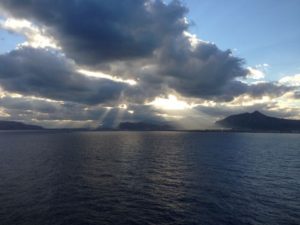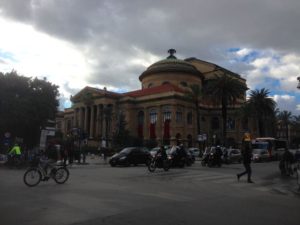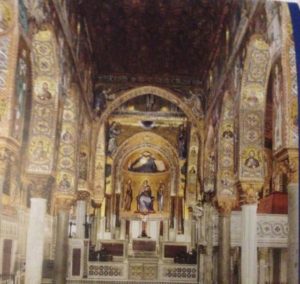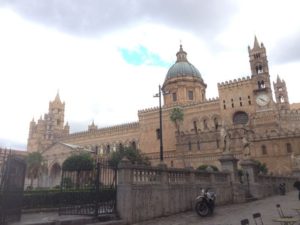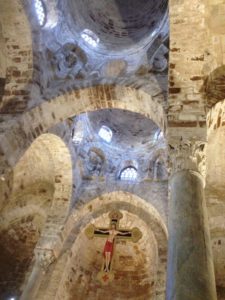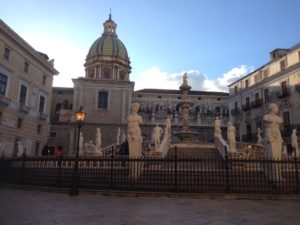We arrived in hilly Palermo as the sun broke through the clouds.
Palermo, the capital of Sicily, was first settled by the Phoenicians, followed by the Carthaginians and then the Romans. In the Middle Ages, it was ruled the Greek Byzantines until the Arabs took control in the ninth century, when it became the capital of Sicily and was enriched with palaces, gardens and three hundred mosques. Then the Normans took over, followed by French and Spanish (Aragon) rule until the 1700’s. Garibaldi’s reunification of Italy included Sicily.
The street plan of Palermo has maintained its original Medieval Arab characteristics, with closed alleys and narrow streets. These passageways branch from two principle streets which in meeting, divide the city into four ancient quarters, “quarto canti.” The 4 statues on each corner were commissioned by the Spanish Viceroy in 1611 and represent the four seasons and the four Spanish kings.
We decided we wanted to go to Monreale to see the mosaics in the Duomo, so we made a b-line up to Piazza Independence where we could catch the 398 bus, a 45 minute ride up to Monreale. We had been warned that Palermo had a reputation as the pick-pocket capital, and sure enough, the moment we got on the crowded bus, Steve was bumped and the man across the aisle pointed to the floor and asked if that was his wallet. The cash had been taken from the wallet but luckily nothing else, and luckily the pick-pocket had left the wallet rather than taking it with him. Luckily, Steve didn’t have much cash on him.
Monreale sits on a hilltop above Palermo with beautiful views of the port and coast. The Duomo was spectacular but very crowded.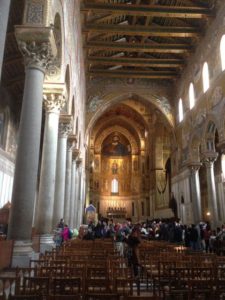
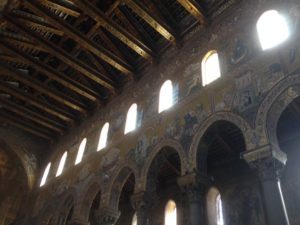
Since the next bus to Palermo wasn’t for an hour, we went to a Van Gogh exhibit, which was very expensive,12 E each, and only had reproductions of Van Gogh’s paintings, so we felt we had been fleeced twice.
Back in Palermo, the Capella Palantina, built in 1130, is just around the corner from the bus stop at Plaza Independencia, costs 7 E but has gorgeous mosaics and was completely empty when we were there.
If I had it to do again, I would skip Monreale and focus on the mosaics in town. The Palacio Reale is only open on weekends, so we missed that.
Next we found the Casa Professa or Chiesa del Gesu, an incredibly ornate Baroque church built by the Jesuits between 1564-1578.
We wandered though the Ballaro, the Arab quarter, finding the market where they were selling fresh vegetables, meat, and fish.
We found the churches of San Cataldo (which opens again at 3) and Santa Maria dell’Ammiraglio (La Martorana) (which didn’t open until 3:30 ). While we waited for them to open Steve found a tiny Indian restaurant where we had an amazing meal of fritters and chicken kebabs for 4 E. The food is cheap but the entrance to churches can be expensive.
San Cataldo, built in 1154, is a tiny, plain Norman church with three red domes.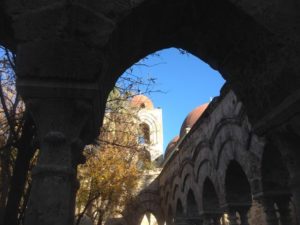
Unfortunately, we had to skip La Martorana because we didn’t have time.
Right beside the two churches is Piazza Pretoria and the “Fountain of Shame” (because it feature naked statues) built in 1555 by the Florentine sculptor Fransesco Camiliani for a Tuscan villa owned by the Viceroy Pedro de Toledo. When his son inherited the villa, he thought the fountain too risqué and sold it to the city of Palermo.
The most unpleasant part of the day (even more than getting pick-pocketed) was getting back onto the boat in a crush of people that took half an hour to get through.




